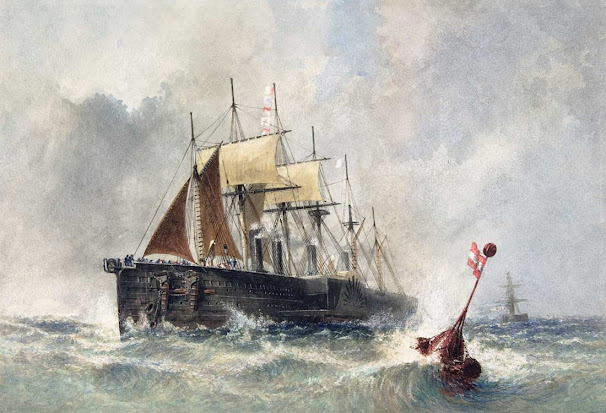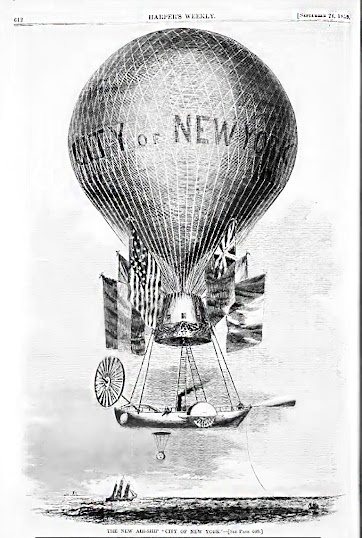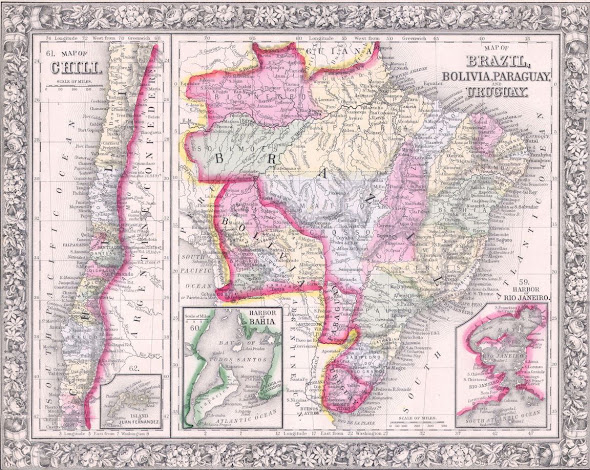1865-1866 The Trans Atlantic Telegraph Finally Successful
The Great Eastern Returning to a Buoy Marking a Break in the Cable
(A painting by Robert Dudley)
Cyrus Field's powers of persuasion must have been enormous. After the spectacular and expensive failure of the 1858 cable he raised funds for another effort in 1865. Though he came from a reasonably prosperous middle class family, Field's rise was really "rags to riches" and his enemies never let him forget it calling him "a junk collector." Though a wealthy man Field was officially a New York City licensed junk collector. His paper mills supplemented wood pulp paper with cotton rags. He had rag collecting contracts much like a recycling company would have today with a steel mill. To keep warehouses full of rags, Field was officially licensed as a "junk collector."
Field kept up with telegraph technology. Blame for the failure of the 1858 cable was tossed back and forth among several of the key players. The real blame though, was the technology still simply was not advanced enough. Field went to England in 1864 to raise funds and interest in another attempt to lay cable. The American Civil War and the 1864 presidential election preoccupied both the American and British money lenders and his efforts failed.
The war and elections over, Field left for England again in July 1865, this time to the nearly universal scorn of news paper editors who predicted failure.
Over the lifetime of the cable project, Field would cross the Atlantic 60 times between 1855 and 1866.
Field convinced the right people on this visit that the technology would offer longer lasting results. The cable would have to be larger, using more copper wires and insulation. Problems regarding the degrading of signals over long stretches of wire had been resolved.
One other new factor was close to hand. The largest ship in the world, the Great Eastern, was available. This was a double hulled iron ship capable of carrying and laying the the entire stretch of cable by itself. Ironically, the ship was as much a product of new technology ahead of its time as the trans Atlantic cable had been in 1858.
Built over a span of six years at the cost of 6,000,000 pounds and launched with great difficulty in Britain in 1860, the ship was the crowning and last achievement of England's greatest engineer, Isambard Brunel.
Isambard Brunel, England's greatest engineer next to anchor chain of The Great Eastern
Five times larger than any other ship, the Great Eastern was propelled by six masts, five funnels for its steam engines, 6,500 yards of sail, two 58 ft. (17m)paddle wheels, and 24 (8m) ft screw propeller. Its coal carrying capacity of 15,000 tons would have allowed it to steam from England to Australia and back without stopping for more coal. A larger ship would not be built until 49 years later! In sum, Great Eastern was the Titanic of its day.
The Great Eastern under construction
Like the Titanic, Great Eastern was designed for the passenger business. At 692 ft (211m) in length Great Eastern had capacity to carry 3,500 or more passengers and 418 crew.
Its enormous cost to build and operate had not earned its investors the hoped for returns, particularly after the American Civil War began. Its maiden voyage to New York in 1860 carried only 35 passengers. By the time Field's offer to refit the Great Eastern to lay cable the ship had passed through several owners at successive bankruptcy auctions. Fields and his partners bought it for 125,000 pounds at its final auction in 1864.
Deck of the Great Eastern in its passenger liner form
The new owners made a canny sweetheart deal. In exchange for using the Great Eastern, they would receive 250,000 shares of stock in Field's telegraph company.
Field increased publicity around this latest effort. He hired the world's most famous reporter, W.H. Russell, and engaged a reputable artist, Robert Dudley, to document the preparations and execution of the project. While Dudley was a respected artist, W.H. Russell was the real name to draw interest. He had become world famous for his war reporting for The London Times from Crimea in 1854. He was the first "name" reporter in journalism history. A reporter and illustrator from the popular American magazine, "Frank Leslie's Illustrated Weekly," were also invited along to record the voyage.
The newly designed cable held more strands of better quality copper along with better insulation and weighed about 2 tons per mile. Passenger quarters were removed and three large tanks designed to hold the coiled cable installed. Then, 2,600 miles of cable weighing 6,000 tons were loaded.
Unwinding the cable inside the Great Eastern
July 15, 1865 the cable was secured in Valentia, Ireland, and the Great Eastern proceeded westward at about 5 mph laying cable. All went well until August 2. At 1,862 miles from Valentia, the cable broke. With no equipment to grapple for a cable more than 2 miles below the surface the Great Eastern
returned to England.
Undaunted, Field set about raising money to try again. This time, he proposed laying the cable as planned and then recovering the end of the broken cable, repairing it and bringing it to Newfoundland as a backup cable.
The departure point in Ireland
Bringing cable ashore
Great Eastern set out again from Ireland July 13, 1866.
Fifteen days later, the other end as successfully brought ashore at Heart's Content, Newfoundland. Test messages passed swiftly between the two continents. Where the 1858 cable could transmit no more than one word a minute, the new cable easily sent eight words a minute.
Inspecting the cable as it is laid from the ship
Testing the cable aboard ship. Field is seated to the far left
Trying to recover the broken cable from the year before now was considered a fool's errand. The Great Eastern's young first officer, Robert Halpin, managed to guide HMS Albany, a ship fitted for deep sea grappling, to the exact spot and recovered the broken cable. Bad luck was not finished with the cable project yet. The cable end slipped loose back into the deep twice before it was brought up a third time and spliced to remaining cable. Once again, the ships returned to Newfoundland and the second cable was connected.
Buoys on the Great Eastern ready to be dropped
Field and his investors went on to do well with their telegraph company.
The ship's owners, Field among them, made a fortune demanding payment in shares of newly forming telegraph companies as their ship was widely used to lay cables across the Indian ocean and elsewhere.
Robert Halpin became captain of the Great Eastern for years, earning a reputation as "the cable man." I doubt he would have appreciated the humor associated with that term now.
The book W. H. Russell wrote about laying the cable along with Dudley's illustrations was such a success that Field advertised an exhibition in his own mansion in Grammercy Park of the original forty watercolors and several oil paintings used to illustrate the book. On his death in the 1892 the artwork was donated to New York's Metropolitan Museum of Art.














Comments
Post a Comment